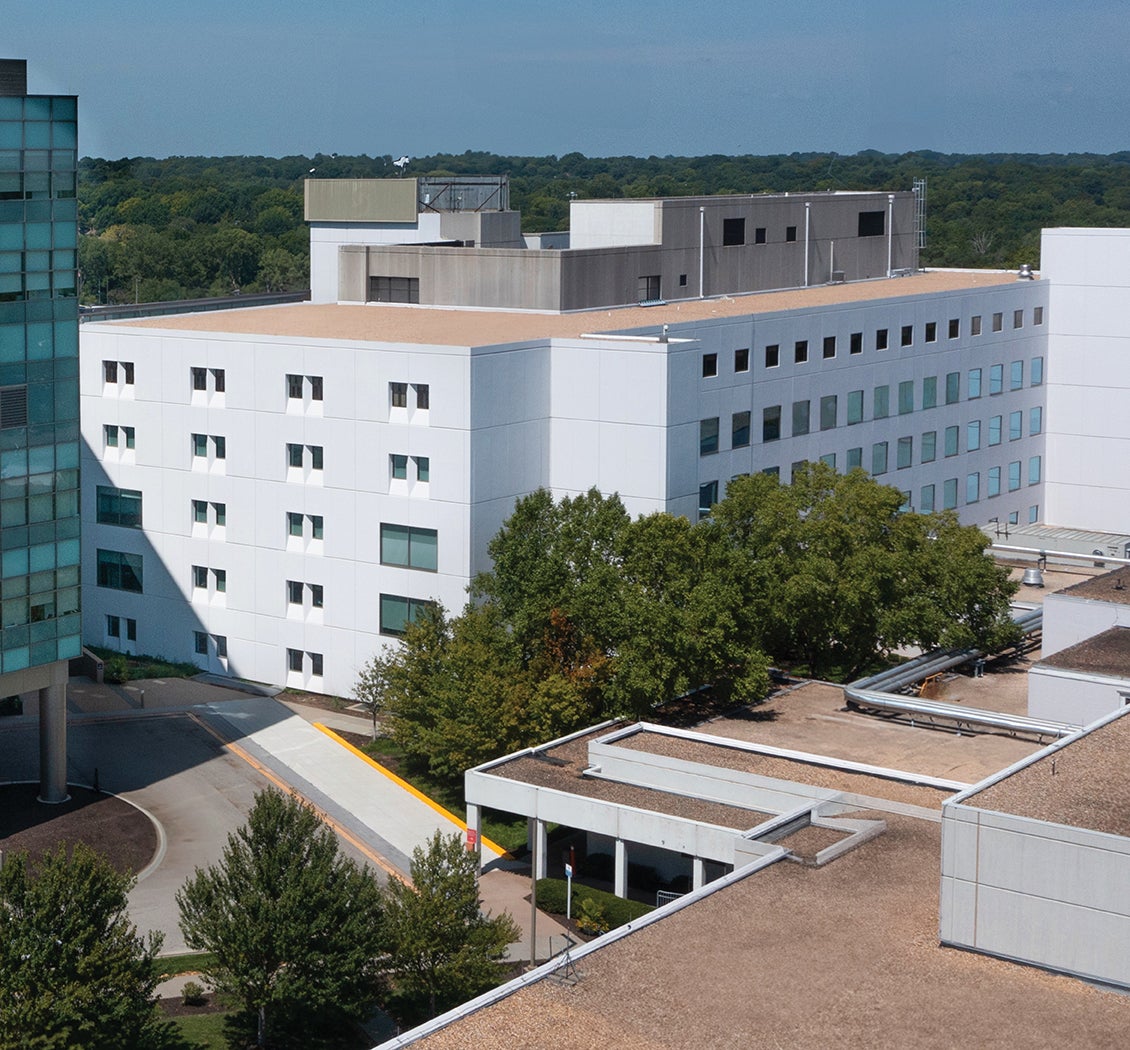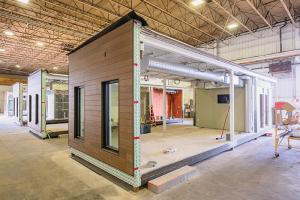2025 Vista Award winner MetroHealth’s The Glick Center
MetroHealth — a 181-year-old, county-owned teaching hospital and Level I trauma center in Cleveland — has long been a vital resource for the underserved in the surrounding community. However, amid a financial turnaround 11 years ago, leadership at parent company MetroHealth System recognized the urgent need to replace aging facilities to maintain high-quality care. A brutally harsh winter in 2014, which nearly forced two hospital evacuations, accelerated this decision.
Later that same year, MetroHealth System unveiled plans to modernize the site, which evolved from a simpler project into a full-scale transformation embodied in The Glick Center, a replacement acute care inpatient hospital tower spanning nearly 724,000 square feet and incorporating advanced technology and design principles aimed at enhancing patient care, improving operational efficiency and fostering a better working environment for staff.
The new structure — which connects to the existing critical care pavilion (CCP) — boasts 386 beds and replaces nearly all of the existing buildings on the main campus. Meanwhile, new renovations in the CCP, including a five-story podium, provide prepartum and postpartum rooms, nurseries, a neonatal intensive care unit, lab, pharmacy, preoperative area, post-anesthesia care unit and rooftop helipad.
“Modern health care demands environments that are conducive to healing, privacy and patient comfort, which the old facilities could not adequately provide,” says Chuck Kostrab, vice president and senior regional operations manager for Cleveland-headquartered Turner Construction. “The new hospital integrates state-of-the-art medical technology and infrastructure to support advanced medical procedures and treatments.”
Future-proof facilities
Understanding the evolving demands of health care and the rising costs of building and updating medical spaces, MetroHealth System prioritized long-term flexibility in The Glick Center’s design.
“We actually reduced the hospital footprint by 132,000 square feet by applying Lean planning principles,” says Mark Bultman, health care market sector leader, principal and vice president of HGA, the Milwaukee-based architectural firm hired for the project. “This reduction in space enhanced affordability of the project and made it possible for MetroHealth to invest in more transformation, allowing the hospital to add 48 additional shelled beds.”
Eileen Hayes, vice president of facilities transition and operational integration for MetroHealth System, says incorporating a universal bed design into The Glick Center made a huge difference. “It allowed us to shift service-line allocations throughout the building since the initial opening. Although it requires an upfront commitment on infrastructure, we were able to make the conversions seamlessly and without added costs,” she says.
A process-neutral approach also was implemented, allowing hospital wards to seamlessly transition between medical-surgical and intensive care unit functions with minimal modifications, ensuring adaptability for future needs. This planning strategy was made possible by renovating the CCP building to house its women’s and children’s center and creating a dedicated hospital entrance there — resulting in $1.2 million in annual operating savings.
To streamline coordination and align project goals with operational requirements, a colocation office brought together key stakeholders, including hospital administrators, the design team and trade partners. This collaborative environment fostered open communication, problem-solving and efficiency through standardized processes and early team engagement.
“The most valuable lesson learned is to be sure to engage the stakeholders throughout each phase of the planning and construction,” adds Hayes. “Engagement ensures a successful transition to the new facility.”
Innovation also played a key role in construction, with prefabricated headwalls, large-scale heating, ventilating and air-conditioning piping systems, and advanced LED lighting — featuring programmable exterior accents and customizable colored cove lights for pediatric and labor and delivery areas — enhancing both functionality and aesthetics. Sustainability was a major priority too, with practices such as no-idling policies, LED temporary lighting, 100% debris sorting for recycling and landfill diversion, and the use of low-flow temporary toilets and faucets reducing environmental impact.
“Historically, health care design focuses on using lots of cool blues, greens and nature in the artwork. But MetroHealth wanted The Glick Center to be a celebration of the community and culture,” Bultman adds. “Design inspiration came from the hospital’s first building, which was a hospital in a park, and the wealth of community art in the surrounding neighborhood. So, inside The Glick Center are a variety of vibrant colors and a range of art styles and subjects.”
Improvements aplenty
MetroHealth’s The Glick Center project delivered remarkable enhancements, surpassing expectations in multiple areas:
- Smart construction techniques and resource management generated $19 million in savings, enabling better allocation of funds. Ultimately, less than 1% of the contingency funds were utilized.
- The building utilizes innovative plant and control technologies to cut heating system fossil fuel use by 80% by repurposing waste heat from chillers cooling the operating rooms. It also reduces water consumption, uses on-site stormwater, and promotes health and wellness through advanced air filtration, daylighting and lighting controls. Overall, the new hospital’s energy performance exceeds the ASHRAE 90.1, Energy Efficiency Standard for Sites and Buildings Except Low-Rise Residential Buildings, benchmark by about 20%.
- An owner-controlled insurance program ensured rigorous safety oversight with monthly inspections and audits. These efforts resulted in exceptionally low incident (0.56) and lost-time (0.09) rates across 2.1 million trade hours — well below the 2021 industry averages of 1.9 and 0.7, respectively.
- Optimized layouts and streamlined workflows boosted operations, cutting patient wait times and increasing staff productivity.
- The upgraded facility fostered improved outcomes, creating a more comfortable and supportive environment for both patients and staff.
Overcoming obstacles
Executing construction in a dense urban setting while ensuring seamless hospital operations during the pandemic (the project launched in early 2019 and completed in November 2023) posed a significant obstacle for the team. This was tackled through strategic planning, phased scheduling and close collaboration with hospital staff to minimize disruptions. Strict sanitary protocols and mandatory face coverings during the COVID-19 pandemic kept the schedule on track without major outbreaks.
The Glick Center
Project info
- Square footage: 723,643
- Number of beds: 386
- Cost: $539.3 million
- Start date: March 2019
- Completion date: March 2023
Team members
- Chuck Kostrab, vice president and senior regional operations manager at Turner Construction Co. in Cleveland
- Jeff Abke, senior project manager at Turner Construction Co.
- Walter Jones (deceased), senior vice president for campus transformation at MetroHealth System in Cleveland
- Mark Bultman, principal and health care market sector leader at HGA in Milwaukee
- Adrian Maldonado, president at Adrian Maldonado & Associates in Berea, Ohio
- Greg Consolo, vice president at Donley’s/Independence Construction in Independence, Ohio
- Mark Perkins, owner of McTech in Cleveland
- Dominic Ozanne, president and CEO at Ozanne Construction Co. in Cleveland
- Michael Zambo, principal at Botswick Design Partnership in Cleveland
- Don Rerko, principal and senior management lead at Makovich & Pusti Architects Inc. in Berea, Ohio
- Jim Cicero, president at Karpinski Engineering in Columbus, Ohio
Midway through construction, shifts in the hospital’s strategic vision led to significant adjustments, including outfitting additional sections of the third and fourth floors and converting 70 rooms to double occupancy to expand patient capacity. Delayed medical equipment selections — made to incorporate the latest technology — required last-minute modifications to critical infrastructure and utility connections.
Despite the complexities of a large-scale project and the hurdles of the coronavirus crisis, the skilled tradespeople involved delivered exceptional craftsmanship for the benefit of future MetroHealth patients. Features such as wood veneer wall coverings, terrazzo floors, custom patient headwalls, printed wall protection murals and uniquely designed ceiling systems showcase the expertise of Cleveland’s workforce.
Nearly 2 million work hours were logged, with only six recordable incidents and a remarkably low recordable incident rate of 0.6, including just one lost-time case.
Rave reviews
“Feedback from patients and staff has been overwhelmingly positive,” Kostrab says about The Glick Center and upgraded CCP. “Patients appreciate the comfortable and healing environment, while staff value the improved working conditions and enhanced facilities for delivering quality care.”
Mark Chrisman, a member of the Vista Awards Task Force that picked the winners, credits MetroHealth System for its focus on the community.
“This project was truly focused on the needs of the community and providing the best patient care possible in an underserved area of Cleveland,” Chrisman notes. “The team worked with the community to make sure they were involved in the early discussions around the design of the hospital and address many of the community health needs. Additionally, the project incorporated many features that will allow for future flexibility and adaptability as the industry and care model continues to change.
“The progressive design and construction method also allowed for project completion ahead of schedule and under budget,” Chrisman adds. “Post-occupancy evaluations indicate that the project is supporting patient health and well-being objectives, including several areas with significant improvement in patient experience scores.”
James Bicak, senior vice president for facilities, construction and campus transformation at MetroHealth, appreciates the recognition that comes from receiving the Vista Award.
“This accolade highlights the accomplishments of a large team of people who worked very hard for years to take the idea of a new and innovative hospital for our community and turn it into the reality that is The Glick Center,” he says.
Erik J. Martin is a freelance writer based in Oak Lawn, Ill.






